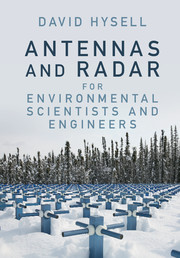Book contents
- Frontmatter
- Contents
- Preface
- 1 Introduction
- 2 Introduction to Antenna Theory
- 3 Antenna Arrays
- 4 Aperture Antennas
- 5 Noise
- 6 Scattering
- 7 Signal Processing
- 8 Pulse Compression
- 9 Propagation
- 10 Overspread Targets
- 11 Weather Radar
- 12 Radar Imaging
- Appendix A Radio Frequency Designations
- Appendix B Review of Electromagnetics
- References
- Index
- References
7 - Signal Processing
Published online by Cambridge University Press: 09 February 2018
- Frontmatter
- Contents
- Preface
- 1 Introduction
- 2 Introduction to Antenna Theory
- 3 Antenna Arrays
- 4 Aperture Antennas
- 5 Noise
- 6 Scattering
- 7 Signal Processing
- 8 Pulse Compression
- 9 Propagation
- 10 Overspread Targets
- 11 Weather Radar
- 12 Radar Imaging
- Appendix A Radio Frequency Designations
- Appendix B Review of Electromagnetics
- References
- Index
- References
Summary
What do you do when radar signals arrive? The answer depends on your objective, the sophistication of your equipment, and the era in which you live. Some aspects of signal processing are common to all radar applications. Some are more specialized. New methods of processing radar data and extracting additional information are constantly being developed.
Traditionally, radar signal processing concerned hard target tracking. Is a target in a particular range gate or not? The answer is inherently statistical and carries a probability of correct detection, of missed detection, and of false alarm. Choices are made based on the costs of possible outcomes. Understanding probability and statistics is an important part of the radar art.
More recently, signal processing has expanded to include Doppler processing (related to the speed of a target) and radar imaging. A range of remote sensing problems can now be addressed with different kinds of radars (SAR, GPR, planetary radar, weather radar, etc.). The signal processing can be complicated and demanding in some cases, but statistics remains central to the problem.
What ultimately emerges from a radar receiver is a combination of signal and noise. The noise component is a random process. The signal may be deterministic (as in the case of one or more point targets) or stochastic (as in volume scatter). In either event, the net output voltage is governed by a probability density function controlled by the signal-to-noise ratio (SNR). It is possible to predict the probability density functions for different SNRs. On that basis, one can examine individual voltage samples and make decisions about whether a target is present. The reliability of the decision grows with the number of voltage samples considered. The merits of averaging are discussed below.
Fundamentals
Most radars are pulsed and can be represented by the block diagram at the top of Figure 7.1. Here, the transmitter and receiver share an antenna through a transmit-receive (T/R) switch. A radar controller generates pulses for the transmitter, controls the T/R switch, controls and drives the receiver, and processes data from a digitizer. The computer also generates some kind of display for real-time data evaluation.
- Type
- Chapter
- Information
- Antennas and Radar for Environmental Scientists and Engineers , pp. 167 - 194Publisher: Cambridge University PressPrint publication year: 2018



